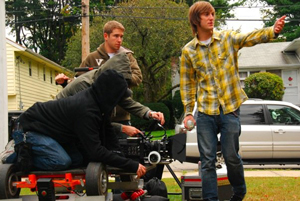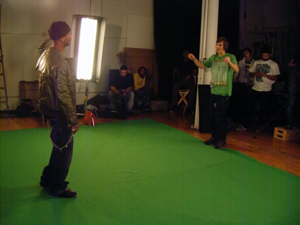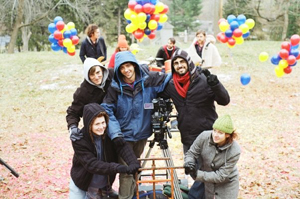Music Video Drive: Hayden 5 Media
CHELSEA, MANHATTAN: Are music videos still big business? You better believe it. The NYC production company Hayden 5 Media is living proof that artists in the five boroughs and beyond are depending on their video image like never before.
Barely a year old, Hayden 5 Media is growing fast under the direction of President/Co-Founder Todd Wiseman. Artists like Doble Filo, Juelz Santana, and Anotha Me have tapped their expertise, which also extends to documentaries, commercials, industrials and et cetera.
Whether you seek the truth on where video fits into your marketing mix, or inspiration on how to convert ambition into real business, read on.

Todd Wiseman (plaid shirt) directs a dolly shot.
Q: What were you doing before you founded Hayden5? Do you have any musical background, or are you strictly a visual person?
A: I grew up in Tampa, Florida. I was actually involved in music my whole life, even into my film career when I ended up scoring a few shorts at NYU. I sang, played the keyboard, and eventually got wrapped up with electronic music.
I had a stint with a small band when I was about 13. We were discovered by Nick Carter from the Backstreet Boys, started getting some local radio play – then we kind of grew up pretty quickly and it all ended. But it was a fun, fast look into the music industry at an early age – something I really benefitted from down the road.
Along the way, you could find me shouldering a VHS camera making short movies from the time I was about eight years old. It slowly but surely overtook music as my passion. In high school I learned editing and began shooting corporate projects for extra cash – the rest is history.
Q: Apparently it was meant to be. From there, what led to Hayden5 being founded?
A: Hayden 5 Media began to take formation in 2005 when myself and a few other like-minded teenagers were randomly placed on the 5th floor of NYU’s Hayden Hall. Like the Def Jam story, and so many others – we we’re hoping for similar luck!
Myself and my neighbor, now my business partner and CEO of Hayden 5 Media, Milos Silber, along with the help of almost the entire freshman floor, put a script together, raised a few grand, got a miracle insurance policy through the university, and made a short film. That experience served as the jump-off point for our long working relationship.
All through film school at NYU, we just kept cranking them out – shorts, music videos, commercial specs, etc… Towards the end of college, we had collected some serious credits – getting 10 grand form Coke to shoot a branded short with Richard Giannotti, now working with us at H5M, getting a few music videos on MTV-U, and so on.
As we approached graduation, Milos and I were apartment roommates, the economy was fucked, and we knew what we had to do. Both of us we’re about to get cut off from the parents, so we pooled cash we had and made Hayden 5 Media, LLC a legal entity. When we got out, we started working form our apartment, and now, a little over a year later, we’re moving into our third office and expanding pretty quickly.
A: The philosophy of the company is do produce content that we deem creative, fun, and worth our time. Everything else, and a lot of what we do day-to-day involves the commercial world – which we love and hate.

Wiseman with Juelz Santana on the set of "Days of Our Lives"
First and foremost – the company is growing and growing fast. With every new employee, office, etc… we have a monthly overhead surging. When you’re in film school and you say to your buddy, “Yeah let’s do this. Let’s start a company!” you can’t foresee the tremendous amount of paper-pushing and accounting that goes along with being creative, but we make it work.
Music videos, for our company, is one of the most exciting things we do. We really get the chance to be creative. Just conceptualizing music videos is one of my favorite things to do. You get to feel the music, close your eyes, and ask yourself, “What kind of visuals are going to bring this song to life? How do I balance promoting the artist and song while making marketable art?” It’s a ride – and that’s only the beginning.
Actually bringing the vision to life is a whole different story, and depending on the level of the artist, you’re now sharing your idea with managers, label heads, etc… Everyone has an opinion, which is always interesting.
I’ve had the opportunity to work with artists I really like to listen to. In 2009 I directed videos for Juelz Santana of Dipset and Benny Benassi. The disparity between the two genres of music is massive, but I’m a pretty eclectic person, and it wouldn’t be strange to find both of those artists on the same play list on my iTunes.
As a director, I like to look at the body of work from an established artist and see if we can bring something new to the table. For Juelz, we did an effects-based video with birds and mountains, etc… We mixed it up for a rap video.
For Benny Benassi, I decided to do the music video entirely with photographs. We took 15,000 still pictures in a stop motion sort of way, and incorporated graphics throughout. I’m looking forward to getting some reactions from that one.
At the end of the day, I have to be prepared to pick up a call at 3:00 in the morning to talk to a rapper who remembered he wanted a hot tub in the video, and then skype the next day at an oddball hour to talk to a graphics guy in India. It never gets boring but the lack of sleep can catch up to you after a while.
Q: That’s extremely deep. Are a lot of music videos being shot today? How has this particular market evolved since the MTV heyday?
A: MTV is out and the Internet is in. While it’s always exciting to see your work on TV, it’s quickly becoming a thing of the past. The future is in the web, and while the music video industry took a hit in terms of super-high-budget productions, it’s shifting in a way that gives directors and artists on every level a better shot at creating a music video and still getting worldwide exposure.

On the set of "Balloon" for the artist Arizona
Internet sensations and viral videos will, in my opinion, take on a much higher level of importance in the future. The new situation forces major and independent artists alike to consider the concept and the materials at hand, and figure out how to make it work with budget constraints. In a way, it’s forcing creativity to be the most important foundation in a music video.
I would say that if anything, more music videos are being made today then ever before.
Q: That’s pretty fascinating. Next up, where do you feel like a music video fits in an artist’s marketing mix? If they shoot one, with you or anyone else, how can they best leverage it to help build their fan base and their bottom line?
A: Music videos are a vital part of an artist’s body of work. In terms of market saturation, the possibilities are endless on the web. Sure, if you can get it on TV then you have that much more exposure, but use all of your resources to get it everywhere on the web.
Get it on blogs, make sure its uploaded to YouTube, Vimeo, Daily Motion, etc… Put it out in as may places as you can. If you’re without representation or a publicist, use your Facebook and MySpace friends to spread the word. Getting a massive amount of views on your video is just as important as spins on the radio. The labels are looking at both.
Q: Sharp advice. What’s Hayden5’s approach to shooting music videos? How do you work with an artist to make the right visual concept to match their song?
A: We’ve worked with artists on every level, so sometimes we have complete creative freedom – and sometimes we have none whatsoever. Ideally, I will meet with the artist and try and grasp their intentions as to how they want to come across.
For new artists, especially if they are doing their first video, it’s important to really solidify their image and get that across in the video. We have to establish their style. We’re introducing them to the world.
Then, in the perfect situation, I sit back in someplace I can focus, close my eyes, and play the song on repeat, sometimes hundreds of times, until I’ve dreamt up the video from start to finish. This all goes into what’s called a “treatment”, complete with very specific descriptions, reference photos, and even time code explaining what happens at each point in the song.
In terms of big breakout videos, I’ll use Britney Spears as an example: Remember her first music video? She was dressed up in a schoolgirl outfit, shaking her ass all around a school, and she really came across as being on the edge. It was light, sexy, packed with choreographed dance, etc… She was an overnight phenomenon.
Q: Which is one of your most recent videos shot for an NYC artist? Describe the concept that unfolded for that video.
A: The most recent NYC video I did was for the new act Anotha Me featuring hype man Fat Man Scoop. They’re two twin sisters that sing and dance – it was something very new for me. The concept was to show them at a “teen” party and keep it clean and lighthearted. We shot at Frog NYC, a club in SoHo, packed it out with colorful lights and kids, and shot the hell out of the video in one day. We pretty much lived on the SteadiCam, had some great cameos come out from the DJ world, and had a lot of fun.
Q: Sounds that way. But what were some of the challenges of that shoot? On the flip side, what made it artistically rewarding for you?
A: Kids and teens are always a challenge, but on this shoot it was pretty seamless on that end. We were shooting with a special flare filter on the RED camera, all moving on the SteadiCam. We wanted the video to have these streaks of light coming in and out from the sides, so we literally had three or four people holding special flashlights with gels wrapped around the glass trying to stay close enough to get the light in without poking into the shot. That was tough, but in the end it turned out to be a really great addition to the video.
Q: What do you want NYC artists, in particular, to know about shooting videos?
A: Let the video guys do their thing. Collaboration is a very important part of this process, but it has to be limited to concept. It’s frustrating when new artists see the lights and the people and the crew, and suddenly they’re sitting in the director’s chair barking orders.
If you’re going to make a music video, be prepared to give up a little control. There is a lot of talent out there. Find a director or a company you think has the know-how to give you the product you want, and let them do what they do best. While they’re getting the video together – just make sure you look great for the production. Be relaxed and be cool. No one likes a diva artist.
Also, if you’re financing your video, be realistic, but don’t be afraid to set a limit to the amount you can spend. One of the favorite videos I did was in Cuba for a band Doble Filo. We had $200 and a government producer. It was an amazing test of cutting costs and getting creative. That said, we were in communist Cuba and things were cheap and we brought all the gear. I always prefer solid budgets that allow me to bring the right people and equipment onto the project. In the end, concept rules. Give me $3,000 or $30,000 and we’ll take what we have and get it done.
Q: You’re HIRED. Why do you think our fair city of NYC is a good place for a small, pioneering production company like Hayden5 to be starting up?
A: In NYC, I feel like I’m in the epicenter of art, culture, and business all wrapped into one. My clients range from the Economist to Def Jam. It’s an exciting place to be.
Q: Right on. Last question: How is video going to evolve in the next five years, in your opinion?
A: Look out for mobile video everywhere! Look out for 3D! Look out for a world where almost anyone with a camera can record a video and get millions of eyeballs watching the content. – David Weiss






